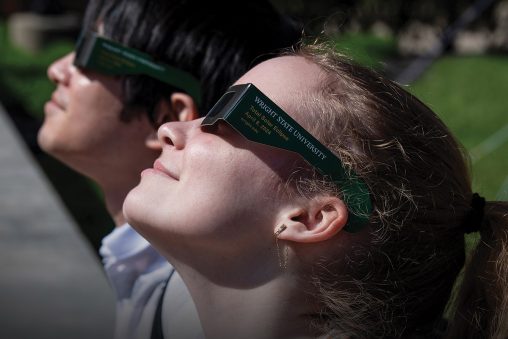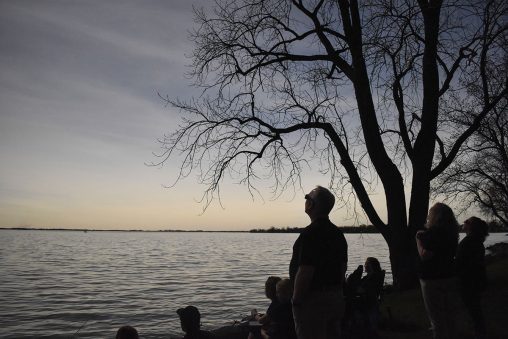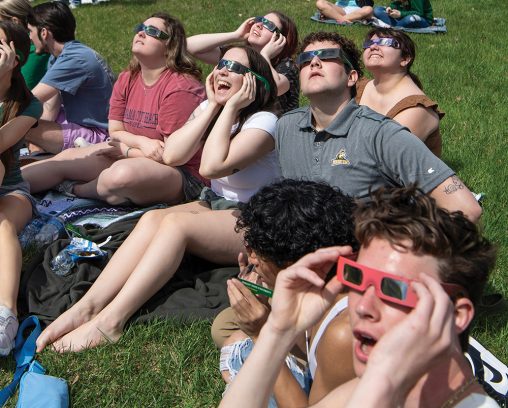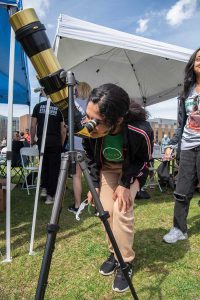
In April, Wright State University was a prime viewing location for the 2024 Great North American Eclipse, a rare event with Ohio last seeing a total eclipse in 1806 and not expecting another until 2099.
By Anthony Shoemaker ’98
April’s solar eclipse was a once-in-a-lifetime experience for thousands at Wright State University. If you missed the 2024 Great North American Eclipse, you’re not going to see another in Ohio for a long time.
Ohio last witnessed a total eclipse in 1806. The next total eclipse over Ohio will be in 2099. There will be total solar eclipses visible in the United States in 2044 and 2045, but you’ll have to leave Ohio to see them.
According to the Ohio Department of Natural Resources, only 21 total solar eclipses have crossed the U.S. mainland in the entire existence of the United States.
Wright State and the Dayton region were just inside the path of totality. Wright State–Lake Campus in Celina was in the center of the path and had close to four minutes of total darkness. Large cities such as Cincinnati and Columbus were just outside of the path, forcing people to travel north to see a full solar eclipse. Ohio lawmakers even added $1 million to the state budget for added security to help with the crowds.
“Our eclipse activities were amazing,” exclaimed Brad Kerry, president of the Wright State Astronomical Collaboration. “We had a couple of food trucks, free swag, solar telescopes, and live music. During the actual eclipse, we had clear skies and were able to see everything! I am guessing we had a few hundred people on the lawns as the crowd.”
Kerry said the view of the eclipse at Lake Campus was great as well.
“Overall, it was just an incredible experience for our students,” Kerry said.

Faculty, staff and students watching the solar eclipse at the Lake Campus, which experienced nearly four minutes of total darkness.
The eclipse crossed 14 states and parts of Canada and Mexico. It crossed all of Ohio in a 124-mile diagonal path starting just north of Cincinnati and moving northeast to Cleveland, one of the largest cities in the country in the path of totality.
Wright State did not cancel classes on the day of the eclipse, but instructors were warned that it may not be the best day for an exam.
“I ask that you plan your Spring 2024 course schedules accordingly to ensure students will not be penalized for missing class that day during impacted class time blocks,” said Amy Thompson, Wright State’s provost and senior vice president for academic affairs, in a January memo. “I suggest you not give any in-class exams or high-stakes assignments during that time.”
Kerry said people are fascinated by eclipses, even though they last only a short time.
The last time Kerry saw an eclipse was when the 2017 eclipse cut across 12 states. He had to travel to Tennessee to see it. “It was so cool,” he said. “The short drive south was normal, but getting back to the Dayton area afterward was a challenge because of the large crowds. It took us 16 hours to get back.”
Kerry said the excitement around the 2017 eclipse helped drive interest in this year’s event. Social media fueled a lot of that attention, and people were excited because another was coming just a few years later.
Kerry has been interested in astronomy as long as he can remember. “I would sneak out when I was young to go look at stars,” he said. “I’d point up as a 2-year-old and be like, ‘star!’”
When Kerry became a teenager, he became quite interested in astronomy. “That’s when I started learning constellations.”

Wright State organized a festive gathering for the eclipse with food trucks, live music, and solar telescopes, ensuring a memorable experience for students and the community.
What is the Astronomical Collaboration?
Kerry, who has a master’s degree in economics, has been with the collaboration for three years. He’s a mathematics student and adjunct faculty member in Wright State’s economics department.
The Astronomical Collaboration is a collaborative effort with the university’s astronomy club and outside sources, according to Kerry.
“We try to make astronomy accessible to everyone, regardless of skill level,” he said.
The organization works with the Ohio Department of Natural Resources to host star-gazing events. They also conduct comet hunting and work with other observatories in the area.
“We’re also trying to develop an AI-driven Mars rover that we’re going to geo-fence around campus and let it interact with students,” Kerry said. The plan is to work with engineering students on the project.
 Eclipse Types and Misconceptions
Eclipse Types and Misconceptions
Ajani Ross, Ph.D., a lecturer in the physics department and the faculty advisor of the collaboration, says eclipses happen more often than people think but are rarely visible at the same location more than once.
“Eclipses are actually not that rare; they are actually pretty common,” Ross said. “An eclipse happens somewhere on Earth an average of about once every 18 months.”
Ross said people who are not astronomers are fascinated by eclipses because “events like this only occur every so often and a lot of times, they only occur in certain places in the lifespan of an average human.”
According to NASA, there will be more than 220 eclipses visible from Earth in the 21st century, but the next total eclipse that will be visible from Ohio will be almost at the end of the century, in 2099. So, you’ll have to travel if you want to see one any time soon.
“If you don’t get to see one in your local area you either have to travel to a place where there’s going to be one, or you may never see one,” he said.
The April eclipse was a total eclipse where the sun, moon, and Earth are in a direct line, causing the moon to look like it totally obscures the sun. This causes the sky to become dark as the moon’s shadow hits Earth.
 Later this year, there will be an annular eclipse. This happens when the moon is farther away from the Earth. This makes the moon look like it has a ring around it from the sunlight. However, the only place in the U.S. you’ll see the Oct. 2 eclipse is in Hawaii.
Later this year, there will be an annular eclipse. This happens when the moon is farther away from the Earth. This makes the moon look like it has a ring around it from the sunlight. However, the only place in the U.S. you’ll see the Oct. 2 eclipse is in Hawaii.
Ross has taught an introductory astronomy course at Wright State every summer and fall since coming back to Ohio in 2015. He graduated from Wright State in 2007, then moved to Dallas to earn a master’s degree and Ph.D. at the University of Texas.
He says that in the future, people may never see an eclipse.
“The orbital path of the moon will eventually be in a position to where, even though eclipses will still occur, they won’t be these large shadows that are cast that we can see on Earth like they are now.”
But that will be hundreds of millions of years from now.
Kerry said a lot of people have misconceptions about eclipses, and the Collaboration likes to correct them. “Some people think that it’s going to be like a full day of darkness. That the sun is always going to be blocked,” he said.
Of course, special glasses need to be worn when viewing an eclipse, but Kerry said some people think they can just use other glasses such as welding goggles. “That’s a big no-no,” he said.
The total eclipse in April happened because the moon lined up between the Earth and the sun. He said some people actually think the opposite happens and the sun moves between the Earth and the moon.
“That would be the apocalypse because we’d all burn to death,” Kerry said.
 For more information about the Wright State Astronomical Collaboration, go to
For more information about the Wright State Astronomical Collaboration, go to
wright.campuslabs.com/engage/organization/astronomyclub. The group has weekly meetings where they stargaze and discuss space and other topics.
This article was originally published in the 2024 issue of the Wright State Magazine. Read more stories at wright.edu/magazine.

 Milling around
Milling around  Wright State recognizes Nursing Professor Kim Ringo for advancing international student success
Wright State recognizes Nursing Professor Kim Ringo for advancing international student success  Wright State honors graduating students for distinguished doctoral dissertations
Wright State honors graduating students for distinguished doctoral dissertations  Top 10 Newsroom videos of 2025
Top 10 Newsroom videos of 2025  Museum-quality replica of historic Hawthorn Hill donated to Wright State
Museum-quality replica of historic Hawthorn Hill donated to Wright State 